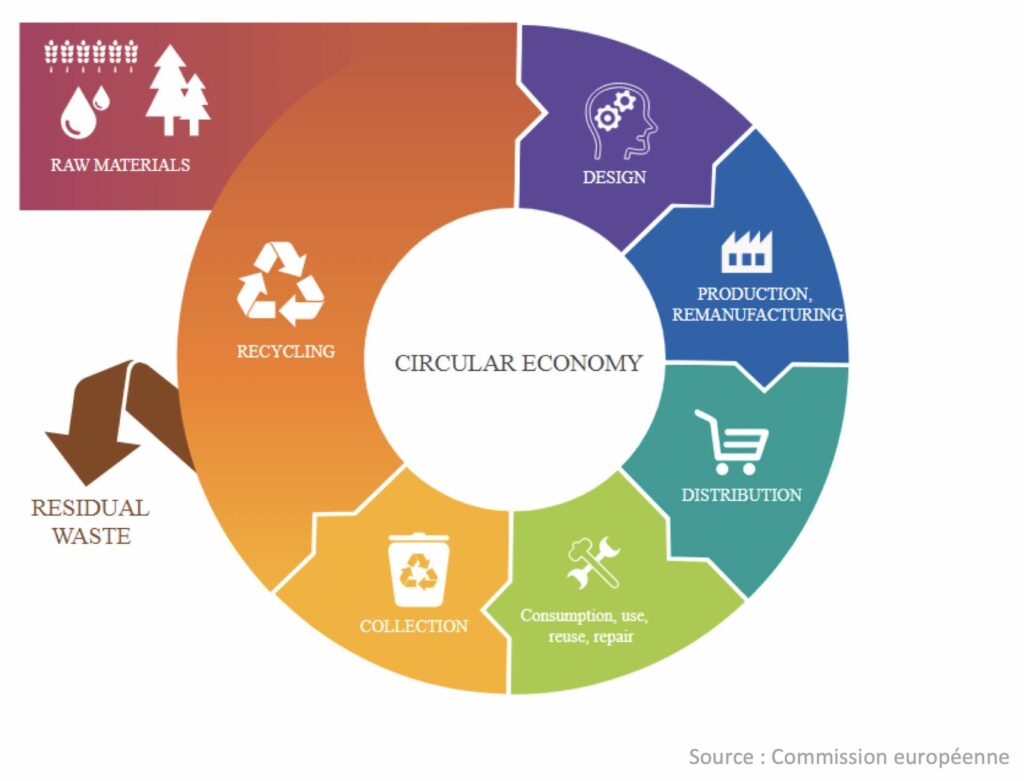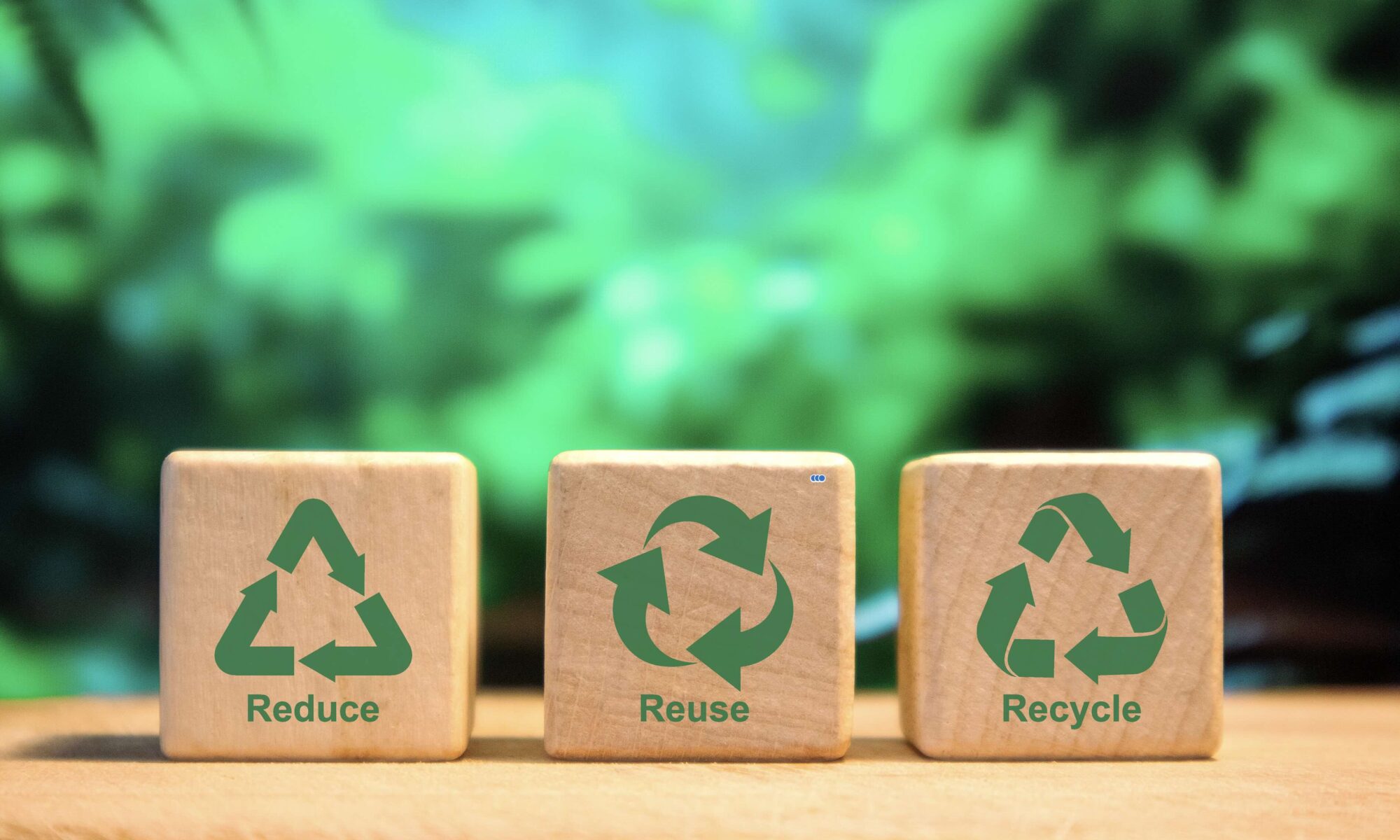What is the circular economy?
For many years, products have been manufactured and marketed with little thought for their ultimate destination. Goods are produced, bought, used and thrown away. From there, they disappear from sight – moved to landfill or, to a limited extent, to be recycled. This linear system is creating an environmental disaster.
According to Statista, the world threw away around 350 million tonnes of plastic in 2023, which is approximatively the combined weight of the world’s human population. On top of that was 62 million tonnes of electronic waste, and one-third of all the food we produce. The World Resources Institute noted in 2020: “Altogether, more than 100 billion tonnes of resources flow into the economy every year, and more than 60% ends up as waste or greenhouse gas emissions.” There’s little indication that the situation has improved significantly since then.
The damage caused by this waste is significant. The United Nations estimates that more than eight million tonnes of plastic enter the oceans annually, at a cost of $8bn in damage to marine ecosystems. At the current rate, by 2050 the world’s oceans may contain more plastic than fish. Non-recyclable waste often goes to landfill or is burned, releasing environmentally damaging greenhouse gases and toxins. Developed nations have been known to ship their waste to emerging countries, passing on the environmental cost.
This linear model looks increasingly unsustainable. Physical resources are finite, and the environmental damage continues to accumulate. This has given impetus to efforts to shift to a more circular economy, based on the principles of designing out waste and pollution, keeping products and materials in repeated use, and regenerating natural systems.
The Linear Model

In a circular economy, the end of a product’s useful life is incorporated into its design process.
Circular by design
In a circular economy, the end of a product’s useful life is incorporated into its design process. The goal is to design products so that they can be dismantled, and the components re-used for new products, or in other ways. The aim, ultimately, is to decouple economic growth from consumption of resources.
The Circular Economy

Several high-profile companies have already started to build this approach into their products and practices. Toy designer and manufacturer Lego, for example, has had to respond to the backlash against plastics. It has found a range of innovative ways to re-use Lego blocks, including using them to furnish its company’s headquarters at Billund in Denmark. Under its Replay initiative, the company passes on used or unwanted products to children in need, and from now on it is using plant-based materials rather than plastic to manufacture its blocks.
Swedish home furnishings group IKEA has taken a similar multi-layered approach. It has introduced a buyback and resell programme under which product owners can return used furniture to be resold, repurposed or recycled. It also enables customers to rent or buy refurbished furniture or other items. It has also changed the materials it uses to manufacture products, prioritising wood and recycled plastic to reduce the company’s environmental footprint.
Computer hardware provider HP set itself a zero waste-to-landfill target for its operations in Brazil through a partnership with Sinctronics, which specialises in reducing the environmental impact of electronics products. The two groups are now increasing the volume of recycled materials in new products and packaging.
Innovation in manufacturing
There is also significant innovation on the manufacturing side. The Ellen MacArthur Foundation, established by a British sailing champion, highlights a range of innovative circular economy initiatives, including Swedish company BoKlok, a joint venture between construction giant Skanska and IKEA.
BoKlok creates prefabricated modular homes through a streamlined construction process that reduces waste, minimises emissions, and significantly lowers build time. A total of 12,000 BoKlok homes are already in existence across Sweden, Finland and Norway, and the group plans to expand into other countries over the next few years.
These initiatives are encouraging, but what does it mean for investors? It makes sense to incorporate circular economy considerations into investment analysis. Companies that make effective use of natural resources are likely to have a more sustainable future.
Companies that can limit their dependency on limited resources and use them more efficiently will have greater growth potential.
Many types of resources are scarce, and in the case of fossil fuels, becoming even scarcer, while water is not necessarily available in the locations and form it is needed. Companies that can limit their dependency on limited resources and use them more efficiently will have greater growth potential. It is also likely to benefit their long-term reputation as consumers increasingly scrutinise companies’ environmental impact.
There are also financial considerations. The regulatory requirements surrounding waste disposal and resource usage are increasing. In December 2017, all 193 United Nations member states agreed a resolution to eliminate plastic pollution in the world’s oceans. In 2023, the EU introduced fresh restrictions on microplastics as part of its circular economy monitoring framework. For a company, being careless with waste and natural resources is becoming more expensive.
Growth opportunities in an evolving economy
Adopting circular economy principles can also provide companies with a runway for growth. Businesses with solutions to improve waste management and recycling are likely to benefit from a growing market. Beneficiaries include companies that produce intelligent control systems for water usage, for example, or technology firms whose software helps companies improve resource management. Other businesses are manufacturing sustainable biodegradable packaging, or finding new recycling technologies and end-uses – all opportunities for long-term investors created by the growth of the circular economy.
International companies are increasingly acknowledging the issue. In 2018, more than 290 groups including international brands such as Coca-Cola, Pepsi, Unilever and Nestlé signed up to a global agreement to eliminate plastic waste and pollution at source. The New Plastics Economy Global Commitment, led by the Ellen MacArthur Foundation in collaboration with the United Nations Environment Programme, has been expanded in subsequent years and now has more than 500 signatories.
The foundation says signatories to the global commitment have avoided using 9.6 million tonnes of virgin plastic since 2018; manufacturers and retailers have reduced plastic use by 3% over a period in which it has grown in the wider packaging market by 8%. Signatories have also increased their use of recycled materials.
Efforts to expand implementation of circular economy principles are likely to gain further momentum, and for investors they should be an important consideration when analysing companies and how they operate. A company’s consumption of scarce resources and how they deal with waste may prove pivotal to their long-term sustainability and financial viability. Companies that do not consider the future of their products beyond the point of sale are liable to fall behind and risk disappearing altogether. To avoid this, it is high time for them to move towards a circular economy.
A company’s consumption of scarce resources and how they deal with waste may prove pivotal to their long-term sustainability and financial viability.


 Mortgage
Mortgage Personal loan
Personal loan Savings
Savings